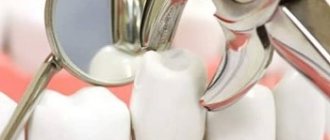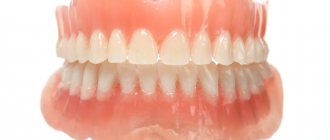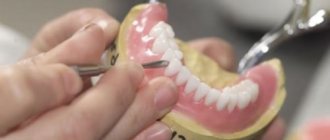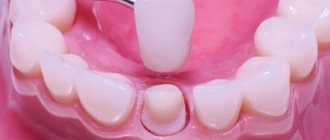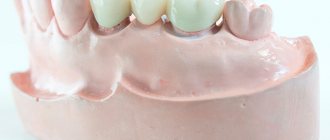The prosthetic procedure is the restoration of damaged or lost teeth, allowing not only to get a beautiful smile, but also to fully realize chewing functions. Various types of dental prosthetics used today make it possible to restore one tooth, several, and even the entire dentition.
First of all, from the point of view of patient convenience, dentures can be removable or non-removable. If it is necessary to replace one or more teeth, dentures are often permanent. In case of complete loss of dentition, previously only removable dentures were used, but today it is possible to install fixed dentures on implants.
Which dental prosthetics should you choose?
The choice of dental prosthetics method depends on the specific situation, the condition of the oral cavity, physiological characteristics, individual preferences and financial capabilities. If the teeth have external defects, but healthy roots, then it is possible to install veneers or crowns.
If 1-2 teeth are lost, they can be restored with a bridge or implants. If most of the dentition is lost (or cannot be restored), then there are 2 main options - acrylic removable dentures or complete dentures on implants using the All-on-4 system (i.e. “all on four”) or All-on -6 (i.e. “all on six”).
Features of complete prosthetics
The clinics of the German Implantology Center in Moscow are a team of expert dentists who constantly improve their skills, participate in domestic and foreign symposiums, and introduce innovations. For more than 11 years of successful dental practice, we have been able to become a leader not only in Moscow, but also in Russia in the field of implantation and prosthetics.
Therefore, dental restoration in our clinics is as comfortable and painless for you as possible - safe anesthesia and sedation are used. The doctor tells you what symptoms may appear in the first days after surgery and prescribes medications appropriate to the case. The doctor is always in touch with the patient until complete healing.
Dental prosthetic options
The main factors that determine the choice of dental prosthetics (if we do not take into account the financial factor for now) are the purpose of the procedure (esthetics or chewing function), as well as the number and location of teeth to be restored. To improve the appearance of healthy (usually front) teeth that have external defects (darkening, chips, cracks, misalignment or size), veneers (special ceramic onlays) or crowns are used.
Crowns are also used to preserve weakened or noticeably damaged (for example, broken or worn down) teeth. They are a kind of caps that are put on a ground tooth. They are made of metal (this outdated technology is still used in some clinics) or modern materials: plastic (temporary crowns), metal-ceramics and ceramics (porcelain, zirconium dioxide, etc.). Both veneers and crowns are non-removable prostheses.
In the absence of 1-2 teeth, either a bridge prosthesis is used - a metal structure (bridge) is attached to the adjacent teeth, used as a support, onto which crowns are fixed, completely reproducing the appearance and function of the lost teeth. Or it will be a prosthesis (crown or bridge) supported by implants.
The advantages of prosthetics on implants are the absence of the need to grind down adjacent teeth, the absence of additional load on them, and the transfer of chewing load to the jawbone (through the metal root), which prevents its atrophy.
The disadvantage is the rather high cost and the need to undergo surgery (implantation of an artificial metal root). If several teeth are missing in a row and it is impossible (or unwilling) to perform implantation, a removable denture is made. For example, clasp (design on a durable metal plate).
In case of complete absence of teeth (edentia), a prosthesis made of acrylic plastic is made. A distinctive feature of removable dentures (both clasp and acrylic) is the ability for the patient to remove and install them independently. The structure is fixed in the oral cavity with special clasps or micro-locks (for clasp ones), or by suction to the gum (for acrylic ones).
Fixed bridge
Restoring teeth with the installation of dentures that the patient cannot remove on their own is called permanent dental prosthetics. These include veneers, crowns (metal-ceramic or ceramic), dental inlays and bridges. Prosthetics on implants is also classified as a non-removable type.
But in some cases, prostheses are placed on implants, which are called conditionally removable. This is due to the fact that you cannot remove them yourself, but a dentist can easily dismantle them by unscrewing the fastening screws - for example, for professional cleaning, repair or replacement. The implants themselves will remain in place.
Crowns
Long gone are the days when crowns were made only of steel and gold. Today, many modern materials are used for dental prosthetics, which are not inferior in strength or aesthetics to natural teeth. The choice of a specific crown material is dictated by both the method of procedure and the financial capabilities of the patient.
Let's look at the advantages and disadvantages of the main types of dental crowns for prosthetics:
- metal ceramics – lining a metal frame with a ceramic composition,
- ceramics – made from porcelain, zirconium dioxide or glass ceramics.
Metal crowns can (and are sometimes) used today. They have undoubted advantages: high strength, teeth need to be ground less for them. But it is necessary to choose solid crowns made of high-quality metal and use them only for the farthest chewing teeth, where they will not be visible.
Ceramic crowns made from porcelain are cheaper, but are the least durable; glass ceramics are the most durable and beautiful, but the most expensive. Zirconium dioxide is the golden mean. Ceramic crowns are not used for prosthetics of chewing teeth due to their insufficient strength for this function. Their area of application is the front teeth, where aesthetics are very important and the chewing function is secondary.
Metal ceramics
Metal-ceramic crowns are excellent for restoring chewing teeth. They can also be used for prosthetics of front teeth, but in this case it is necessary to check their compatibility with existing natural teeth.
Metal-ceramic crowns are opaque (otherwise the metal base will show through the coating), so if your front teeth have a high coefficient of transparency, then teeth with crowns will differ from natural ones. If, nevertheless, a decision is made to prosthetize the front teeth with metal-ceramics, then it is better to choose crowns with shoulder mass, since they do not cause cyanosis of the gums, unlike conventional ones.
Complete dental prosthetics
In case of complete absence of teeth, it is necessary to make a removable or fixed denture. The removable option involves making an artificial jaw from polymer materials (acrylic, nylon, etc.). The structure is fixed in the oral cavity by suction to the gums, just like a suction cup is attached to glass.
The production of such a prosthesis is quite fast, their prices are moderate, and installation does not involve any serious interventions. However, they also have serious disadvantages. The prosthesis must fit perfectly. If it does not fit perfectly, or if during use the shape of the soft tissues has changed slightly (and it will change, because the design does not transfer the chewing load to the jaw bone, which is why bone atrophy will continue), then the prosthesis will not hold well and keep falling out.
The removable version is very massive, extends far beyond the dentition, rests on soft tissue and in some patients causes a gag reflex. Getting used to such a design is a very slow matter (up to 1 month), and some people do not manage to get used to it at all. Hard dentures often rub the gums during chewing, while soft dentures distribute the load unevenly, causing discomfort. The service life of removable polymer dentures is 5-7 years in the most favorable case.
An alternative is complete dental prosthetics using fixed (or conditionally removable) structures supported by implants. The most commonly used are 3 methods: basal implantation, prosthetics on 4 implants (All-on-4) or prosthetics on 6 implants (All-on-6). Basal implantation means the placement of 8-12 elongated implants into the dense layers of the jaw bone.
The advantage of this method is the absence of the need to do bone augmentation, the ability to do without cutting the gums and drilling the bone, the initial strong fastening of the implants, which allows you to immediately install a prosthesis on them. On the other hand, placing a large number of implants makes the procedure more complex, and the lack of large-scale studies of the behavior of implants over many years does not allow for firm guarantees, unlike other implantation methods, which provide a lifetime guarantee on the implants.
Prosthetics on 4 implants
More predictable and well-researched is the method of dental prosthetics on 4 implants. It also allows you to receive a ready-made fixed prosthesis within 3 days after surgery. But the peculiarity of this type is that this design will be temporary and will have to be replaced with a permanent one in a few months (from 5 to 24 months, depending on individual characteristics).
The main difference between the different types of temporary structures is the presence of a metal frame. A temporary prosthesis with a frame is optimal - it is strong enough to last 2-3 years before being replaced with a permanent one. But embedding a metal frame with a screw connection with implants into an acrylic base is a very labor-intensive procedure, due to which the cost will be noticeably more expensive.
An acrylic temporary denture without a metal frame will be cheaper, but it has noticeably less strength, which is why its service life does not exceed 5 months, and even during this time, structural failures are common, especially in men with large and well-developed jaws. A temporary (adaptation) prosthesis must be properly maintained - once every six months (and sometimes more often) it requires professional cleaning by a dentist, and once a year - replacement of the fixing screws.
There are many types of permanent structures for all-on-four prosthetics, so the desired option is selected individually in each clinic, according not only to the specific clinical situation (for example, the amount of space for dentures, determined by the degree of atrophy of the jaw bone), but also to the capabilities of the clinic and the patient.
The highest quality are titanium-polymer prostheses from Nobel Biocare, however, they are characterized by high cost and require a large amount of space for prosthetics, i.e. Patients with a slight degree of bone atrophy will not be able to install them.
Another option is bridge-like structures made of zirconium dioxide or metal ceramics. Their frame can be made of titanium or zirconium dioxide, and in some cases of nickel-chromium alloy, but the beam must be milled. The use of cast structures reduces the strength and accuracy of fit, which can lead to problems in the future.
Prosthetics on 6 implants
The previous method is not suitable for all patients. In large men, young men (under 55 years of age), those who prefer solid foods (meat, fresh vegetables), and those with very soft bones, implants located on the side will experience increased stress, which will inevitably lead to their loosening, resorption of bone tissue around the implants and breakage (or loss) of the prosthesis after a few years.
For such patients, dentures with 6 implants are always recommended as a more reliable and suitable option to avoid overloading the lateral implants. The operation can also be performed using surgical guides or the traditional method with incisions. Loading of installed implants with a prosthesis can be performed within 2-3 days after surgery.
To install a prosthesis, it is better to use branded Multi-unit abutments, since to remove the prosthesis in the future (if it is necessary to clean or replace a temporary one with a permanent one), Multi-unit abutments, unlike standard ones, allow you to remove only the prosthesis, and other abutments will have to be removed along with it , injuring the gums, which creates a risk of infection and the development of inflammation of the tissue around the implants, and this, in turn, can lead to rejection.
A temporary (adaptive) prosthesis is usually included in the cost of prosthetics using the “all on 6” system, just like the “all on 4” system. And the permanent one will have to pay extra. Temporary, as already discussed above, it is better to choose one with a metal frame, especially for men, even though it will be more expensive. It is better to choose a permanent one based on milled titanium or zirconium beams, or, in extreme cases, cobalt-chrome beams. Cast beams are significantly less strong and their fit is less precise.
It should be noted that prosthetics using the “all on 4” and “all on 6” systems always imply implantation with immediate loading, i.e. the prosthesis (temporary) is placed immediately - within 3 days after the operation. Some clinics offer installation using a delayed loading protocol - i.e. after 4-6 months, during which you will have to use a conventional removable acrylic denture. But this is not an “all on 6” (or “all on 4”) technique, but a conventional two-stage implantation.
Partial prosthetics
In the absence of part of the dentition, partial dental prosthetics is performed using a bridge or clasp prosthesis. Those. In this case, structures can be removable or non-removable. To install a fixed bridge, healthy abutment teeth must be preserved at the edges of the edentulous area. The bridge is a metal arch on which crowns are located, simulating missing teeth.
Along the edges there is a system of attachment to the supporting teeth. They are ground down and crowns are also put on them. In the absence of supporting ones, it is possible to install a bridge prosthesis on implants. A removable bridge with partial absence of teeth also implies that the structure will be attached to the supporting teeth. These can be dentures made of acrylic or nylon, or clasp ones.
Partial plastic dentures have clasps with which they are attached to the supporting teeth. Because of this, this type of denture is not used in cases where the supporting ones are located in the smile area, because the clasps will be visible. In addition, such dentures can cause discomfort and pain when chewing. It will be more convenient to install clasp frames.
Clasp prosthetics
A characteristic design feature of clasp dentures is a special metal arch (clasp). In the upper jaw structure it passes through the palate, and in the lower jaw it passes behind the front teeth, adjacent to the alveolar ridge of the jaw bone. The metal base is made of titanium, cobalt-chrome alloy, or precious metals.
Its strength makes it possible to reduce the total weight of the structure and the thickness of the plastic base, which has a positive effect on the ease of use of the prosthesis. For clasp dentures, the supporting teeth located on both sides of the jaw must be preserved.
This is one of the most optimal options for a removable bridge, because:
- clasp dentures effectively restore chewing function,
- firmly fixed on the jaw,
- do not impair diction,
- have a long service life.
To fix the clasp structure, various mechanisms are used - clasps (wire loops), micro-locks and telescopic crowns. The best, most reliable and aesthetically impeccable are clasp dentures with micro-locks and especially telescopic crowns.
They have one drawback - they are very difficult to manufacture and require highly qualified orthopedists and dental technicians, and therefore have a higher cost. But they better transfer the chewing load to the supporting teeth and practically do not cause their destruction, which, for example, occurs with the clasp system on clasps.
Prosthetics of lower teeth
The procedure has a number of features. First of all, aesthetic requirements for the lower teeth are less stringent, since the lower teeth are not as visible as the upper teeth. Also, the lower teeth are subject to a much greater chewing load, which places greater demands on the strength of the prosthesis and the reliability of its fixation.
And in addition, the anatomical features of the lower jaw (absence of a hard palate, frenulum of the tongue, etc.) make dentures difficult, making the task of achieving a strong fixation of the prosthesis much more difficult. As a result, prosthetics for the lower teeth turns out to be somewhat more complex, and the dentures may have a slightly different design. However, the same technologies apply to the lower teeth.
To restore healthy teeth with partial external damage, veneers and crowns are used here, and if 1-4 teeth are completely lost, a permanent bridge can be installed, supported by ground adjacent teeth. Or a removable plate made of acrylic or nylon, with clasps made of metal wire or polymer material.
If there are supporting teeth on both sides of the jaw, it is possible to install a clasp prosthesis, the design of which will differ from that used for prosthetics of the upper teeth in the shape and location of the arch. In case of complete edentia (absence of teeth) in the lower jaw, the dentition is restored using a removable full plate bridge, or a conditionally removable one on implants.
The latter option has a secure fit and impeccable functionality. In the lower jaw, implantation is easier, and the higher bone density often makes it possible to avoid lengthy and expensive bone augmentation surgery. Implants completely imitate natural teeth, including transferring the chewing load to the jawbone, which slows down its atrophy and allows you to use the prosthesis without correction or replacement for a longer time.
Prosthetics of anterior teeth
Front teeth always play an important role in a person’s appearance, so their restoration is almost always an urgent and pressing task that is important to solve as quickly as possible. As a result, prosthetics of the front teeth is associated not only with recreating the shape and appearance of the tooth itself, but also with the aesthetics of a smooth and beautiful gingival margin.
You can correct aesthetics (darkening, abrasion and small chips, gaps between teeth) with the help of veneers or lumineers, and you can restore severely damaged teeth by installing crowns on them. When one or more front teeth are lost, the problem of prosthetics is best and most effectively solved by installing implants.
The chewing load on them in this area is minimal, and quick prosthetics after tooth loss eliminates bone resorption and makes bone grafting unnecessary. When implanting with immediate loading, the patient receives a fully functional structure immediately (however, several months later, after the implant has completely engrafted, the prosthesis will have to be replaced with a permanent one).
In the case of a two-stage implantation protocol, while the implant is healing, the hole is closed with a temporary butterfly prosthesis, fixed with polymer clasps to the adjacent teeth. And after a few months, a gum former is placed, and after another 3-4 weeks - a permanent option. If implantation is not possible, one of the best options would be to install a clasp prosthesis.
Urgent prosthetics
If it is necessary to restore the integrity of the dentition as soon as possible, the patient is offered emergency dental prosthetics, which usually involves installation within one day. These can be temporary removable structures made of acrylic or nylon, other types of plastic, or non-removable ones - for example, temporary crowns. This type of dental prosthetics is used during tooth extraction and during the restoration process.
Another option is express implantation. Installation of a special implant with a bioactive surface can be non-surgical, or rather performed without an incision in the gum. A temporary crown or prosthesis can be immediately installed on such implants.
A characteristic feature of urgent prosthetics is that it is always a temporary structure that must be replaced with a permanent one after some time. Such prostheses are not very durable and have a limited service life.
Turnkey prosthetics
When calculating the cost of dental prosthetics, it is important to take into account all the nuances and costs at all stages. Clinics often try to show a lower cost of the procedure, without including in the price list the cost of some materials or procedures, which the patient will nevertheless have to pay.
That is why such an item as turnkey prosthetics arose. This means that by paying the specified amount, the patient will receive a fully functional prosthesis and will not have to pay anything else for this. However, it is necessary to take into account that in some cases the turnkey cost includes only the cost of manufacturing and installing a temporary prosthesis, which will later have to be replaced with a permanent one.
The cost of a permanent structure and its installation is not included in the price of the turnkey procedure, primarily because the permanent structure is installed several months (6 or more), or even 2-3 years after temporary dental prosthetics. And it is simply impossible to calculate in advance the cost of permanent dentures for months and years in advance, without knowing what type of prosthesis will be installed and how prices will change.
Features of implantation and prosthetics on the lower jaw
The artificial root is more firmly fixed in the tissue, so the risk of rejection tends to zero. The mandibular bone atrophies more slowly after the loss of units, which reduces the likelihood of osteoplasty. For complete dental prosthetics on implants, we use the “All on 6” technique more often in most clinical cases. This guarantees the patient reliability and ease of use of the orthopedic construction, primarily in the long term.
The aesthetic side is important, but when working with the dental row below, more attention is paid to restoring functionality. There is a nuance: the surgeon’s work will require precision, since the trigeminal nerve passes at the base of the jaw and there is a risk of damage to it if the intervention is careless.
- Before implantation begins, during diagnostics the exact location of the branch of the trigeminal nerve is established, the structure of the tissues and the localization of nerves and vessels are clarified.
- Surgeons at the Research Center clinics are highly qualified, carry out diagnostics and know everything about the anatomical features of each patient, so implantation takes place without complications.
- The doctor selects not only the location of the implant, but also its size, which is especially important in the absence of teeth. If the location is too close, then the nerve trunk will need to be docked.
Example #5 - Lower jaw prosthetics on 6 implants ALL ON 6
Our patient is a woman with fairly progressive views on dental treatment and prosthetics. But a rather serious problem in her life is an allergy to antibiotics. Since she categorically did not want a removable denture, considering it archaic and uncomfortable, the patient began her independent attempts to improve her smile. And she did this at her own peril and risk in several clinics.
At first, she installed the implants without “covering up”—the subsequent use—of antibiotics. Some of the implantation went well, some not so much. Having suffered, the patient concluded that she still needed to turn to professionals and then, even without antibiotics, she would get the reliable and aesthetically beautiful result that she dreams of and really wants to achieve.
The photo shows a view of 6 implants installed on the lower jaw:
Photo after prosthetics
:
You can read more about this interesting clinical case HERE.
Stages and timing of dental prosthetics
The specific plan and order of all dental prosthetic measures in each individual case may be different, depending on which teeth are to be restored, what technology is chosen, etc. Any procedure always begins with an examination of the patient, assessment of the condition of the dentition and the necessary diagnostic procedures.
After this, the doctor, together with the patient, develops a detailed treatment plan. The stages of dental prosthetics may include grinding down teeth - to install veneers or crowns, or to fix a bridge or clasp prosthesis. Another important stage is taking impressions, from which the dental technician will make crowns or dentures.
The accuracy of the fit of the prosthesis and the ease of use in the future depend on the quality and accuracy of this procedure and the choice of the most suitable material. In order for everything to be done with the utmost precision, jaw modeling programs are used, the work of the jaw joints and muscles is revealed, and the closure of the teeth of the upper and lower rows is studied.
A mandatory stage of the dental prosthetics process is the manufacture of the prosthesis in the laboratory. This is labor-intensive jewelry work, the quality of which determines how successful the fitting of the design will be, whether adjustment is needed, how comfortable the use of the prosthesis will be for the patient, how quickly one can get used to it and how long the system will last.
After the prosthesis is made, it is tried on, modified if necessary, and then fixed. Very often, before installing a permanent option, which may take several months, the patient is given temporary structures, which will need to be dismantled before installing a permanent structure. And finally, after installation of the prosthesis, there is an adaptation period.
In the case of prosthetics on implants and installation of anatomically accurate structures, adaptation takes a matter of days. When installing complex and removable bridges, getting used to it can take a month. In general, it is simply impossible to say in advance how long prosthetics will take. This can only be determined by a doctor after examining a particular patient and choosing the surgical technology.
Preparing teeth for the procedure
Before the procedure, it is necessary to carry out a number of activities, which can take from one to several months. In particular, you will need to carry out professional oral hygiene and cure all your teeth. It may then be necessary to remove non-restorable teeth and their roots, and sometimes also to correct the bite or position of the teeth using braces.
If implantation is planned, it may require bone grafting. Therapeutic preparation of teeth for prosthetics includes complete sanitation of the oral cavity - professional cleaning, removal of tartar, treatment of caries and periodontitis, depulpation of those teeth that cannot be cured in any other way and those that are intended for grinding to fix dentures.
The surgical preparation stage involves the removal of severely damaged and incurable teeth, removal of soft and hard tissue pathologies, bone augmentation before implantation (for example, sinus lift), as well as the implantation operation itself. The orthodontic and orthopedic stages involve correcting the bite and straightening the teeth using braces.
This is important not only for beauty, but also to ensure that the load after installation of the prosthesis is distributed evenly - the health of the remaining teeth and the service life of the prosthesis depend on this. Protruding teeth are also sharpened and secondary deformities are corrected. All stages of preparation are extremely important and directly affect the quality of the procedure, ease of use of the prosthesis and its durability.
Selecting a method
Which dental prosthetics to choose in a particular case is determined by the nature and scale of dental defects - how many and what teeth are missing, how healthy the existing teeth are and what methods need to be used for their treatment and restoration. This will also require the necessary diagnostics - x-rays, tomography, laboratory tests, studying the patient’s health status.
Of course, the patient’s requirements play an important role - what result is needed and what financial capabilities he has. Some patients are willing to wait several months, while others need urgent prosthetics. Some agree to implantation, while others are contraindicated for medical reasons. In each specific case, the choice of technique and procedure plan is a compromise between desires and capabilities.
How are dentures made?
The manufacture of the prosthesis itself does not greatly affect the time of dental prosthetics - it takes only a few days. Much more time is spent on preparatory procedures, waiting for implants to heal, and adaptation to the finished structure.
After impressions are made and digital 3D models of the jaw are created, the impressions are transferred to plaster casts in the dental laboratory. Subsequently, structures made of titanium, zirconium dioxide, various alloys, and polymer materials are created using special equipment. Ceramic crowns require firing and sometimes painting. Installation of a finished structure
The manufactured prosthesis must be tried on. If the fit is incomplete or inaccurate, the doctor corrects it or sends it to the laboratory. If it fits perfectly, the doctor fixes it in the oral cavity. Correction may be required in the future due to changes in the tone of the masticatory muscles, malocclusion, and bone tissue atrophy due to the lack of chewing load on the bone.
Next, the doctor instructs the patient how to use the denture - what can be chewed and what cannot, how often and thoroughly should be cleaned, when to come for an appointment to inspect the structure, professional cleaning, and, if necessary, repair or replace components.
How are dentures attached if the last supporting teeth are missing?
If we mean a complete absence of teeth, then various types of complete prosthetics, which we discussed above, are suitable. If the teeth are preserved, for example, in front and we are only talking about restoring the lateral chewing teeth, then it is possible either clasp prosthetics on implants (which will provide the necessary support for the prosthesis), or the installation of removable dentures made of acrylic or nylon, or clasp prosthetics with support on the front ones teeth.
Reasons for missing teeth
1-2% of the population has a genetic disorder in which teeth are initially absent or their number is abnormally small. In the vast majority of cases, the absence of lower or upper teeth is a consequence of illness or mechanical damage. Doctors at the clinic name the main reasons:
- Untreated caries or pulpitis. Tooth tissues are destroyed, in advanced cases, inflammatory processes in the gums begin, and the bone structure changes. Our dentists try to preserve every unit. But, if the process is already irreversible, then it is necessary to remove one tooth or several.
- Inflammatory processes in periodontal tissues lead to the fact that the ligament cannot hold the tooth in the socket. The crown becomes loose, destructive phenomena progress, and the gums and bone are destroyed.
- Injuries. The complete absence of teeth or partial adentia is caused by dislocations, bruises, fractures of the tooth crown or root, and other damage resulting from mechanical impact.
Sometimes teeth can be lost after suffering from somatic diseases: oncological, endocrine, and others that weaken the immune system and affect the structure of tissues.
Pain after prosthetics
After installation of the orthopedic structure, the patient may experience pain. They are mainly caused by either adaptation of oral tissues to the elements of the prosthesis, or the development of inflammatory processes. Pain due to adaptation goes away on its own or after correction of the structure.
But pain after dental prosthetics, caused by inflammation, is fraught with dangerous consequences, so if they last longer than a few days, do not subside, but intensify, are accompanied by an unpleasant odor, the discharge of pus, it is urgent, without delay, to consult a doctor.
The cause of pain may be untreated foci of infection in the oral cavity, infection as a result of errors in the installation of the structure or previous preparatory operations, violation of the rules for using the prosthesis and oral hygiene, allergic reactions to the materials used in dental prosthetics, as well as too tight, or, conversely, , insufficiently tight fit of the prosthesis to the soft tissues.
In order to identify the causes of inflammation and cure it, it is necessary to contact a dental clinic, otherwise this can lead to breakage of the prosthesis, rejection of its structural elements and serious complications.
How to get used to removable dentures
The time it takes to get used to dentures depends on the rigidity of the construction material and its stability in place. The better the orthopedic product is fixed, the easier it is for a person to get rid of the feeling of discomfort, and in this case, the chewing function is more effective. In the first days of using the prosthesis, the body will perceive it as something foreign and try to reject it. To make it easier to get used to, you should:
- do a light massage of the gums;
- leave the structure in the mouth overnight;
- perform articulation exercises when diction is impaired;
- try to get used to excessive salivation or dryness - they will pass in a few days;
- If damage or wounds appear, consult a dentist;
- eat soft food until full adaptation, do not load the jaw.
In some cases, patients complain of vomiting. If possible, it is recommended not to remove dentures or to reduce the time they are worn to the maximum possible. If it is not possible to reduce sensitivity and reduce rejection, then try to install a partial removable denture, which is better accepted by the body.
Indications for prosthetics
The main indications for dentures are:
- loss of one or more teeth as a result of illness, injury,
- serious defects in the dentition - chips, cracks, wide gaps between teeth,
- unstoppable erosion of tooth enamel,
- destruction of the crown of one or more teeth.
Some indications are subjective - for example, aesthetic defects such as uneven teeth, slight darkening or natural yellowness of the enamel. In such cases, there is often a desire to improve aesthetics, make teeth smoother, more uniform and more beautiful.
In all cases, the doctors at the Dental Master clinic will help you gain beauty and self-confidence, as well as restore chewing ability. We perform all types of prosthetics - quickly, efficiently and at affordable prices.
Caring for partial and complete dentures
It is important to consider that the described orthodontic structures, both full and partial, are not suitable for biting and chewing solid food. When using them, it is advisable to consume well-chopped soft foods.
After eating, it is necessary to rinse removable dentures. And twice a day they need to be brushed using a non-abrasive toothpaste.
Removable dentures can be in the mouth around the clock. After the adaptation period has passed, you can sleep without them if you wish. With this solution, the structures are washed and placed in an airtight container or wrapped in a damp cloth. You should not take too long (more than a week and a half) breaks from wearing them.
If you have partial or complete removable dentures, an annual routine dental examination is required. You also need to urgently see a specialist if chips, cracks or any other structural defects appear. A timely visit to the dentist will help avoid serious complications and longer and more expensive treatment.
Expert of the article you are reading:
Akhmedkhanov Said Rashidovich
Dental surgeon, general dentist, implantologist, orthopedic dentist, dental therapist.
You may also be interested in:
Partial removable denture Crowns on the front teeth Quadrotti denture Acri-Free denture Removable nylon denture Temporary crown on an implant Dental bridge Nylon dentures
Show more
Bridge prosthesis
If several back teeth are missing, a bridge can be installed. It is a permanent structure with artificial crowns, which is placed on supports. The following can act as supports:
- pre-ground living crowns,
- implants,
- pins or stumps fixed in the root of the tooth - they are used if the crown is destroyed, but the root remains strong.
Installation of a bridge is possible only if there are supports. If they cannot be created, you must choose another method.
Bridge on implants
The ideal solution is to replace the full number of missing teeth with implants. But not everyone can “pull” its financial side. For such patients, experts offer a solution: install a bridge on implants. Such a decision becomes a reasonable compromise, and in certain situations it turns out to be the most rational option.
In this case, even before dental prosthetics, titanium “roots” are implanted. They are intended to serve as supports for the bridge structure, and their number will be less than the number of missing teeth. You also save on paying for the services of an implantologist, whose workload is reduced.
The procedure is carried out in three stages. First, a bed for the artificial root is prepared and a titanium implant is implanted. Then wait the allotted time until the healing process (osseointegration) is completed. This period varies for the lower and upper jaws and averages 3 and 6 months, respectively. After this period, supports for the prosthesis - abutments - are installed. After another time, a bridge is erected on top, which is made of metal ceramics or zirconium oxide.
How many implants are needed?
Possible options:
- 2 classic (two-piece) implants are implanted along the edges of the defect, after healing they are loaded with a permanent prosthesis of 3 connected crowns (2 “sit” on the implants at the edges, 1 in the middle fills the void);
- 3 classic (two-piece) implants replace missing teeth with individual implants and load them with separate crowns after implantation of artificial roots;
- 3-4 monoblock (one-stage) implants on titanium roots immediately fix an adaptive prosthesis with a titanium arch and three welded crowns.
The choice of the number of implants depends on the location of the defect.
Why is fixed prosthetics better than removable prosthetics?
Preventing bone atrophy With complete removable dentures, the main part of the chewing load is transferred to the mucous membranes, so bone tissue resorption begins. Implants function like real tooth roots. The chewing load is distributed onto the artificial teeth as if they were your own. Bone loss stops.
Reliable fixation A removable denture covering the entire jaw can fall out at any time. Fixed prosthetics on implants eliminates the risk of falling out. It eliminates the constant fear that the denture will fall out of the mouth at the most inopportune moment.
Preservation of taste/heat sensitivity A complete denture covers the palate. As a result, the taste and heat receptors of the oral cavity do not work.
Full restoration of chewing function A complete removable denture restores the chewing ability of the dentition by only 20-30%.
Prices
| Service | Price |
| Prosthetics with partial removable plate dentures | from 17,000 rub. |
| Prosthetics with partial removable lamellar dentures (immediate denture) | from 7,500 rub. |
| Prosthetics with removable clasp dentures | from 40,000 rub. |
| Dental prosthetics with complete removable plate dentures (immediate denture) | from 8,000 rub. |
| Restoring the integrity of the dentition with fixed bridges (tooth) | from 14,700 rub. |
| Restoring the integrity of the dentition with fixed bridges (crown) | from 18,400 rub. |
To avoid possible misunderstandings, please clarify the cost of services in clinics with the administrator or during a consultation with a doctor. Prices on the website are not a public offer.
Sign up for a consultation
Types of dentures for chewing teeth
The choice of which dentures to put on chewing teeth largely depends on how well the tooth is preserved. In a situation where it is severely destroyed, but a sufficient part for support has been preserved, the traditional option for prosthetics in the absence of chewing teeth would be crowns.
- Metal-ceramic.
Consist of a metal frame and a ceramic top layer. The combination of materials makes the structure durable and quite aesthetic. Such crowns last up to 15 years. However, to install a metal-ceramic crown, you have to grind down the abutment teeth quite heavily. - Ceramic.
They are made entirely of ceramics and perfectly imitate natural enamel, its transparency and texture, preserving its aesthetics for a long time. Ceramic crowns are strong, but at the same time fragile, so they are installed on chewing teeth in rare cases - they will withstand a lot of pressure, but can chip if exposed to a sudden force. - Zirconium.
Orthopedic structures made of reliable and durable material. The price of a chewing tooth prosthesis made of zirconium will be significantly higher than metal-ceramic and ceramic analogues. They can withstand heavy chewing loads, and at the same time are visually almost identical to natural teeth. The structures will last up to 20 years. - Ceramic based on zirconium dioxide .
One of the most aesthetically pleasing, and at the same time incredibly durable: resistant to chipping and cracking and able to withstand heavy loads. Crowns are carefully adjusted to the anatomical features of a person and provide strength equal to metal-ceramic structures.
Operation stages
1. Consultation
The doctor listens to the patient, determines the condition of the teeth, gums and the advisability of implantation, and answers the patient’s questions.
2. Diagnostics
The patient is sent for an x-ray. A 3D computed tomography (CT) scan is performed. Helps to exclude contraindications and assess the volume and condition of bone tissue.
3. Preparation
They organize treatment of dental pathologies (if they are diagnosed), and carry out professional cleaning of the oral cavity.
4. Installation of implants
After anesthesia, the implants are implanted using the method of detaching the gum flap, followed by suturing the gums (with a two-stage protocol) or fixed through a puncture (with a one-stage implantation).
5. Prosthetics
If the operation is organized in 2 stages, 2-6 months after the implantation of titanium roots, the patient is fitted with permanent dentures with crowns made of zirconium dioxide or metal ceramics. While the bone is fused with the implants, the patient wears a temporary removable denture. In a one-stage protocol, the installed artificial roots are loaded with an adaptive prosthesis 2-3 days after surgery. Re-prosthetics with permanent structures are organized after a year.

